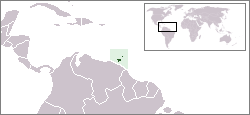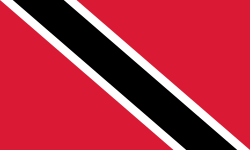

The following outline is provided as an overview of and topical guide to Trinidad and Tobago:
Contents
- General reference
- Geography of Trinidad and Tobago
- Environment of Trinidad and Tobago
- Regions of Trinidad and Tobago
- Demography of Trinidad and Tobago
- Government and politics of Trinidad and Tobago
- Branches of the government of Trinidad and Tobago
- Foreign relations of Trinidad and Tobago
- Law and order in Trinidad and Tobago
- Military of Trinidad and Tobago
- Local government in Trinidad and Tobago
- History of Trinidad and Tobago
- Culture of Trinidad and Tobago
- Art in Trinidad and Tobago
- Sports in Trinidad and Tobago
- Economy and infrastructure of Trinidad and Tobago
- Education in Trinidad and Tobago
- Infrastructure of Trinidad and Tobago
- See also
- References
- External links
Trinidad and Tobago – sovereign island nation [1] located in the Lesser Antilles Archipelago in the southeastern Caribbean Sea. [2] Trinidad and Tobago lies northeast of Venezuela and south of the island nation of Grenada. It also shares maritime boundaries with Barbados to the northeast and Guyana to the southeast. The country covers an area of 5,128 square kilometers (1,979 sq mi) and consists of two main islands, Trinidad and Tobago , and numerous smaller landforms. Trinidad is the larger and more populous of the main islands; Tobago is much smaller, comprising about 6% of the total area and 4% of the population.
Officially Trinidadians or Tobagonians, the people from Trinidad and Tobago are often informally referred to as Trinbagonians or Trinis (for Trinidadians). Unlike most of the English-speaking Caribbean, Trinidad and Tobago is a primarily industrialised country whose economy is based on petroleum and petrochemicals. Trinidad and Tobago is famous for its pre-Lenten Carnival and as the birthplace of steelpan, calypso, chutney, chutney-soca, pichakaree, chut-kai-pang, cariso, kaiso, parang, soca, and limbo.






